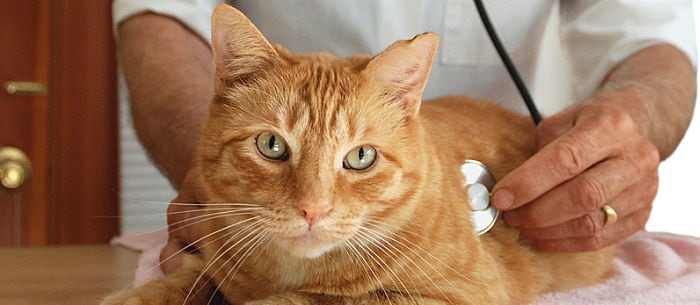Does Mr. Whiskers have less get up and go than usual? It’s time for a checkup because he may have the flu. And though you may only need to curl up on the couch when you have the flu, the illness can be serious in cats and may require treatment. Learn what to look for and how to keep your feline friend flu-free.
What is Cat Flu?
When someone says their cat has the flu, they’re actually talking about a set of symptoms that mimic a cold or flu in humans, but it’s actually a misnomer, as cat flu is not caused by a strain of influenza. “It’s a bad idea calling it cat flu because it’s really an upper respiratory infection that’s most often caused by two common viruses: feline herpes (FHV) and feline calicivirus (FCV),” explains Dr. Margret Casal, Ph.D., a veterinarian and an associate professor of medical genetics at the University of Pennsylvania School of Veterinary Medicine. “Cats can also get the same flu strains we get, though it’s less common than what’s typically referred to as cat flu,” she adds.
Your kitty’s symptoms might include sneezing, coughing, fever, lethargy, discharge of the eyes and nose and red puffy eyes. “One of the viruses causes oral lesions on the tongue and those cats won’t eat. Cats with severe nasal discharge also stop eating because they can’t smell and when cats can’t smell, they don’t eat,” says Dr. Casal. Some of the same symptoms do occur in cats outside of illness.
“You’ll know the difference because discharge caused by dust irritation, for instance, will clear up quickly, whereas a respiratory infection will take more time and sometimes doesn’t clear up all the way,” says Dr. Robin O’Neill, a veterinarian and the owner of Animal Care Clinic in Aberdeen, South Dakota. Noticing a few symptoms in your cat is probably nothing to worry about, but many persistent symptoms accompanied by changes in behavior and appetite warrant a trip to the vet.
What Causes It?
Several pathogens cause the infection, but FHV and FCV are the most common. Your cat can contract the viruses by coming into contact with another cat, being touched by a human who handled an infected cat or using the same food bowl, litter box or toys as a sick cat. Some cats are born with FHV and may exhibit symptoms when stressed.
Additionally, pet sitters sometimes unknowingly bring the virus into houses on their shoes so even indoor cats can contract it, though their exposure risk is lower, explains Dr. O’Neill. Younger cats are at higher risk due to weaker immune systems.
How is it Treated?
Your cat’s treatment plan depends on what your vet determines the cause of the respiratory infection is. “An antibiotic may be administered to prevent or treat a secondary infection or an anti-inflammatory medication may be used in cats that are severely congested,” says Dr. O’Neill. If your cat exhibits these symptoms, it’s important to go to the vet. Most cats will fully recover from the flu with proper care at the onset of symptoms.
You can also take precautions at home to keep your cat comfortable, such as:
- Heat up Food
Dr. Casal recommends slightly heating up canned cat food — especially a smellier fish-based one such as tuna — not to make it hot but to enhance the aroma, so your congested cat can smell it and is more likely to start eating.
- Offer Soft Food
If your cat has mouth sores, offer canned food or wet kibble down with water to make it less painful to eat.
- Make it Steamy
Dr. Casal recommends steaming your bathroom up by running a super hot shower, then sitting in the steam with your cat for five minutes. It’ll help loosen the discharge and aid healing.
- Use a Humidifier
Dr. O’Neill recommends keeping a humidifier running to help with congestion.
And make sure you vaccinate your cat, because vaccines can prevent the most common causes of the infection. “Most people vaccinate their cat every three years, but it’s important to get a checkup once a year,” explains Dr. Casal, adding, “cats don’t show sickness until they are very, very sick, but your vet may catch something before it gets serious with regular checkups.” If a vaccinated cat does contract the virus, symptoms will be less severe than in an unvaccinated animal.
Victoria Georgoff is a freelance writer, psychotherapist, lover of all animals and owner of a delightfully fluffy cat named MJ.
*This article is for general informational purposes only. It is not intended nor implied to be providing medical advice and is not a substitute for such advice. The reader should always consult a health care provider concerning any medical condition or treatment plan. Neither Care.com nor the author assumes any responsibility or liability with respect to use of any information contained herein.



